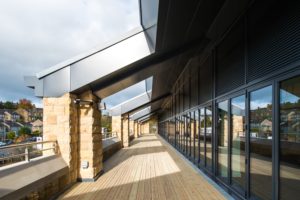ISG secured the contract to deliver a new headquarters for innovative healthcare technology company TPP in the form of a four storey, steel-framed office building above a reinforced concrete box to house two under-croft levels of car-parking.
However, it could not foresee that the contract would generate hundreds of individual changes, requiring numerous time extension negotiations that would almost double the original length of the build, and grow the value of the project to more than £20M before its completion in October 2015.
In September 2013, senior project manager for ISG’s UK Construction North business, Anthony Mitchell, found himself in charge of what would be a challenging 109-week development. He set the scene: “The design of the building was complex: set on a sloping site the front of the building would have three storeys, dropping down a storey at the back. The front elevation was to be clad in traditional Yorkshire stone, while the back would have a contemporary design with modern bi-fold doors opening all the way along several terraces and balconies. Its structure would require a combination of materials and bespoke items, from a major concrete-fill challenge to create the carpark, to a skeleton made up of custom delta beams, shipped from Slovakia.”

© DanD photography
With such design diversity, the master programme was complex. Anthony had a working knowledge of Powerproject, worked on the proposed programme from the outset, identifying the links which would affect the sequencing of the build, and understanding the critical path activities. Once on site, he used the software to help him keep work moving apace and streamline planning updates: “Our planner came out once each week to do a general update of the plan, to report progress to the directors and to update the client. It meant I didn’t have to worry about the overall programme and its links; instead I could easily create short term programmes for specific areas and sub-contractors. I developed an approach of colour-coding each gang working on each area of the site to avoid clashes. I could create a programme just for the dry-liners, for example. I could keep everyone happy, plan around issues, and help ensure everything was finished on a timely basis. It worked beautifully: I would feed my programmes back to the planner who could simply insert them into the overall plan, so we could see any effect it would have on the end date.”
He continued: “My office wall became adorned with colourful diagrams, which were extracts of the entire programme, short term analysis, charts to indicate any potential for delay or cause for concern, and sub-contractors’ individual tasks, helping to avoid clashes whilst ensuring continuity of work on site. I’m a big advocate of planning to the smallest detail to ensure a smooth-running project and I firmly believe that helps to achieve a more organised and also safer site.”
In working through some of the conundrums presented during construction, Anthony conceived numerous value-engineering options. He saved over £500,000 on the window systems, and the same again on the metalwork, roof tiles and boarding system. But such money-saving initiatives were not the only challenge. Anthony outlined one such instance: “Changing the method of construction of the basement early on led to the most delays, and we used Powerproject to negotiate the first extensions of time. We worked on the plan with the groundworks contractor, and figured out how to re-sequence the entire basement. It resulted in a two-week delay, which could have been far longer – but it laid down a benchmark, by showing the client how we mitigated issues.”
The main project planning challenge was to be the hundreds of variations requested by the client – many of them on site and with little time to respond. Anthony successfully negotiated seven extensions of time, totalling 193 days, by demonstrating the impact of changes on the end date with the help of Powerproject. He explained:“The small variations such as moving sockets somewhere different than on the drawings we could manage – but some were at the other extreme, such as deciding to use a different quarry for the Yorkshire stone, just before building started. The beauty of Powerproject is that we could demonstrate exactly how changes would affect the sequence, and therefore the end date, of the programme. We could advise our client, even while changes were being considered, on what the effect would be if they went ahead. We used Powerproject to give our client intelligent foresight all the way through the process, so they didn’t make decisions without knowing the consequences.”

© DanD photography
The result of Anthony’s laser-like focus on managing activities and people created a superbly ordered, safe and incident-free site, which won two RoSPA Gold awards. The client was proud to show the development off to local dignitaries and even the then Prime Minister, David Cameron, who visited the site mid-build.
Although he had limited experience of the software prior to the Horsforth development, Anthony said: “I think Powerproject is really good. I got a real buzz out of drawing up and working through programmes, and I’ve been able to start linking programmes up and seeing the effect when an activity moves. It helps our communication with trades too, because there is greater clarity of work completed and what is scheduled to happen.”
Anthony’s handling of the project, its many changes, and the value delivered for the client were outstanding, and a Construction Manager of the Year Award quickly followed. He concluded: “To me, the key to good project management is always communication. You have to establish trust and honesty with the client, all the way from start to finish. Powerproject helps us do that. We can have really collaborative meetings and discussions, so the client always knows what they are getting and what is happening. It all helps our client make decisions.”
Although experienced contractors like ISG are very used to working around challenges and fielding client variations, the construction of a new headquarters for TPP at Horsforth, north of Leeds, tested the project team. It used Powerproject as its planning platform for a project which would require numerous changes and negotiations for extension of time. The result was a stunning building and accolade for its project team leader.
ISG is a dynamic construction services company with more than 2,800 specialists worldwide.
If you would like to read more articles like this then please click here.
The post ISG takes change in its stride at Horsforth, Leeds appeared first on UK Construction Online.

